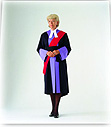Examples
Judges have their own title and in some cases their own distinctive style of dress, which may change depending on the type of case they are hearing.
The horsehair wigs and colourful robes worn by judges can be traced back to medieval times. And although they’re now a tradition, both robe and wig started out as essential fashionable attire for polite society.
Judicial attire has changed over the years – for example, shoulder-length wigs are now only worn on ceremonial occasions – and judges hearing family cases in private tend not to wear robes in order to keep the atmosphere more informal.
Court Working Dress Reforms – October 2008
On 1 October 2008 reforms to Court working dress for judges hearing civil and family cases were introduced. Judges hearing such cases now wear a new civil robe, without a wig.
Robes for judges hearing criminal cases were unaffected by the changes, although High Court judges’ court dress was simplified. Where previously High Court judges wore different robes for summer and winter, they now wear winter robes in summer and winter alike.
Examples
What different members of the judiciary wear, including details of the changes introduced in October 2008.
The Heads of Division and Court of Appeal
The Lord Chief Justice, the Master of the Rolls, the President of the King’s Bench Division, the President of the Family Division and the Chancellor, and Lords Justices of Appeal.
Dress: For criminal hearings Heads of Division and Court of Appeal judges wear a court coat and waistcoat (or a sleeved waistcoat) with skirt or trousers and bands (two strips of fabric hanging from the front of a collar), a black silk gown and a short wig.
When presiding over civil cases this group of judges wear the civil robe introduced on 1 October 2008, with gold tabs at the neck of the gown and no wig.
High Court Judge
 High Court judges are sometimes known as “red judges” because of their colourful robes, but their dress codes are actually more complex than that.
High Court judges are sometimes known as “red judges” because of their colourful robes, but their dress codes are actually more complex than that.
Red robes are usually worn only by judges dealing with criminal cases.
High Court judges presiding over civil cases wear the civil robe introduced on 1 October 2008, with red tabs at the neck of the gown and no wig.
Judges hearing Family Division cases in Chambers do not wear court dress.
High Court judges sitting in the criminal division of the Court of Appeal wear a black silk gown and a short wig.
On Red Letter Days, which include the sovereign’s birthday and certain saints’ days, all High Court judges wear a scarlet robe.
Circuit Judges
 Bands worn over a violet robe and a short wig.
Bands worn over a violet robe and a short wig.
When hearing criminal cases, circuit judges wear a red tippet (sash) over the left shoulder.
When dealing with civil business, circuit judges dress as in criminal cases, but with a lilac tippet and without a wig or bands, wing collar or collarette.
On some occasions – when dealing with certain types of High Court business, or when sitting at the Central Criminal Court (Old Bailey) in London – circuit judges wear a short wig and black silk gown over a court coat and/or waistcoat.
District Judges
In open court district judges wear the civil robe introduced in October 2008, with blue tabs at the neck and without a wig.
Deputy District Judges
In open court, Deputy District Judges wear a black coat with bands, a King’s Counsel’s or junior barrister’s gown with no wig.
High Court Masters Group
In open session members of the High Court Masters Group, which includes Masters of the Chancery or King’s Bench Division, District Judges of the Principal Registry of the Family Division, Bankruptcy Registrars and Costs Judges, wear the new civil robe introduced on 1 October 2008, with pink tabs at the neck and no wig.
Recorders
Whether sitting in the Crown or County court, Recorders wear a black coat with bands, a King’s Counsel or junior barrister’s gown.
Magistrates
In court magistrates wear clothing which provides a professional and dignified appearance.
Tribunal Chairmen and Judges
In Tribunal suits are worn.
Examples of the new civil robes
 |
 |
| Male robe | Female robe |
